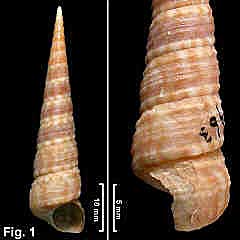|
|
|
|
Gazameda gunnii (Reeve, 1849) Description: Protoconch 2 whorls, teleoconch 18 whorls in adult shells. Whorls straight-sided, suture impressed. Whorls spirally ribbed; latter whorls with a low, angled rib at upper suture and a rounded rib at lower suture and 2-10 spiral threads between, variable in strength. Axial sculpture of growth lines conforming to shape of outer lip. Inner lip of aperture reflected outwards weakly at base; outer lip thin with sinus, lip usually broken. Base with weak and indistinct spiral threads. Colour white with pale brown or purple-brown bands around centre of whorls and wavy axial brown streaks. Operculum circular, corneous. Size: Up to 69 mm in length, commonly 30-40 mm. Distribution: Endemic to Australia; Cape Moreton, Queensland, southwards to northern and eastern Tasmania. Habitat: Recorded from about 8 m to at least 140 m in depth; frequently found as a beach shell in Twofold Bay. Lives in sandy mud, and muddy and gravelly sand. Common. Comparison: See G. tasmanica Synonymy: Turritella philippensis Watson, 1881 is a synonym. Remarks: The sculpture of this species is very variable. Either the upper or the lower main spiral rib may be the stronger, and either may be beaded. Ribs on the centre of each whorl may be numerous and quite weak, or be restricted to 2 or 3 which approach the lower rib in strength. The lower rib may be so strongly developed that it overlaps the whorl below. Shells from northern NSW and southern Queensland usually have four ribs only, all equal and strongly developed. As part of a survey to gather baseline data on the marine environment off Sydney, and to investigate the effect of a sewerage outfall, Carrick (1980) conducted a detailed investigation of the anatomy, reproductive biology, reproductive strategy and feeding biology of this species. He found it to be of common occurrence, but reduced in population near the Malabar sewerage outfall. It employs dual modes of feeding; when plankton concentration in the water is high it is mainly a ciliary feeder, filtering small particles of food from the water current that is drawn across the gills. When suspended food concentration is low it becomes a deposit feeder. It reproduces by maintaining its embryos within a brood pouch in the mantle cavity. The embryos emerge as crawling juveniles at a size of about 3 mm after an incubation period of about 200 days. The animal had a normal life span of about six years, but this was reduced to four in the vicinity of the sewerage outfall. Fig. 1: Off Port Kembla, NSW, in 91 m (C.337963). |
